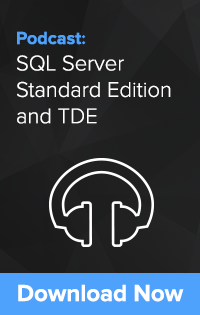Microsoft handed everyone a big gift with SQL Server Standard Edition 2019. The Standard edition of SQL Server did not previously support encryption. Surprise! Now it does. Prior to this new version, SQL Server Standard customers had to upgrade to the Enterprise Edition, or install a third party encryption solution. Upgrading to the Enterprise Edition was expensive for many small to midsize Microsoft customers, so bringing encryption to Standard Edition with 2019 is a big deal.
Let’s take a dive into SQL Server Standard Edition 2019 and the encryption support:
How Encryption is Implemented
 Microsoft implemented encryption in Standard Edition by bringing the EKM Provider architecture from the Enterprise Edition to the Standard Edition. This means that Standard Edition users have access to the same encryption and key management capabilities that are available in the Enterprise Edition. This is great news for Microsoft customers as most are running both Standard Edition and Enterprise Edition in their IT infrastructure. You can now deploy the same encryption and key management solution across your Standard Edition and Enterprise Edition databases. If you are using Transparent Data Encryption (TDE) in the Enterprise Edition, you can now do the same thing in Standard Edition.
Microsoft implemented encryption in Standard Edition by bringing the EKM Provider architecture from the Enterprise Edition to the Standard Edition. This means that Standard Edition users have access to the same encryption and key management capabilities that are available in the Enterprise Edition. This is great news for Microsoft customers as most are running both Standard Edition and Enterprise Edition in their IT infrastructure. You can now deploy the same encryption and key management solution across your Standard Edition and Enterprise Edition databases. If you are using Transparent Data Encryption (TDE) in the Enterprise Edition, you can now do the same thing in Standard Edition.
Earlier Versions of Standard Edition and Upgrades
The new encryption capability for Standard Edition is only in the 2019 release (version 15.x). Earlier versions of SQL Server Standard Edition will not be upgraded to support encryption. To take advantage of encryption in Standard Edition you have to upgrade to the 2019 release. You do NOT have to upgrade to the Enterprise Edition!
Encryption Key Management
How you manage encryption keys is crucial to your encryption strategy. SQL Server provides you with two key management options:
- Locally stored on SQL Server
- Deployment of a key management server through the EKM Provider interface
The only secure way to manage your encryption keys is through the use of a key management system that is registered and accessed through the EKM Provider interface. Our Alliance Key Manager for SQL Server solution implements support for the EKM Provider interface and provides you with all of the software you need to protect SQL Server encryption keys.
Compliance Regulations
Many Microsoft customers are rushing to implement encryption in order to meet the new California Consumer Privacy Act (CCPA) requirements. Your only protection from class action lawsuits in the event of a breach is through encryption of sensitive data, and proper protection of encryption keys. Storing encryption keys on the same server as the protected data will NOT provide you with CCPA protections. See California law AB 1130 for more information about encryption key management and data breaches.
Cloud Considerations
It is very common to deploy SQL Server Standard Edition in a virtual machine on a cloud platform. You can easily do this on Microsoft Azure and Amazon Web Services (AWS). When you deploy SQL Server Standard Edition 2019 in the cloud you have full access to the encryption key management using the EKM Provider interface. Be aware that many cloud service provider database services (AWS RDS, Azure SQL, etc.) do not support the EKM Provider interface and limit your ability to deploy key management. If you are concerned about cloud independence be sure to avoid these types of Database-as-a-Service offerings.
You can run Alliance Key Manager as a dedicated key management server for your SQL Server Standard Edition database applications in Azure and AWS. You will find Alliance Key Manager in the Azure and AWS Marketplaces. You can even run Alliance Key Manager in your own data center and protect SQL Server in the cloud. You are never locked into a cloud platform.
ISV Solutions with SQL Server Standard Edition
Many software solutions are built on SQL Server Standard Edition. SQL Server is an affordable relational database and you will find it in both cloud-based SaaS solutions as well as on-premise solutions for the Enterprise. For our ISV partners we make it easy to embed our Alliance Key Manager solution into your software offering to achieve better security and compliance. If you are an end customer running an ISV application and you need encryption, talk to us about an introduction to your vendor. We will make it easy for your software vendor to upgrade and support encryption.
Alliance Key Manager for SQL Server
For more than a decade we have been helping Microsoft SQL Server customers achieve the best security for their database and applications. We now fully embrace encryption and key management for SQL Server Standard Edition. As an end user or an ISV partner, there is an affordable and easy-to-use solution waiting for you. You can learn more here.













 As we work with Microsoft customers who are implementing encryption with Extensible Key Management in SQL Server 2008 R2, the question inevitably arises about whether to use
As we work with Microsoft customers who are implementing encryption with Extensible Key Management in SQL Server 2008 R2, the question inevitably arises about whether to use 